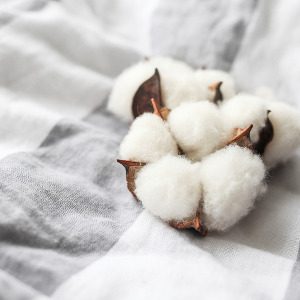There is no one right way to shop thrift for fashions. Some thrifters immediately check the brand name, while others have a whatever-looks-good approach. Another way to shop thrift fashions is by fabric and be more eco-friendly, considering the material of a clothing item, which is found on an inner care label. Each fiber type has unique characteristics that can help determine if that piece fits your needs for a certain season or occasion. Some fibers are also valued at higher prices, so knowing about them can help you decide to bring that high-value, one-of-a-kind item home!
If it’s important to you to make purchasing decisions from a mindset of eco-friendliness and sustainability, check out the energy used in the production of various fibers.
View fiber production energy consumption
Credit: https://www.thehouseofpillows.eu/polyester-shouldnt-be-in-your-bed-blog/
Isn’t it interesting how synthetic fibers require more energy to be produced than natural fibers due to their use of fossil fuels but generally cost less to the consumer?

Cotton
Cotton is a natural fiber from the boll of a cotton plant and is one of the most ancient fibers on the planet. Its first use dates back to India in 5000 B.C.
- Pros: Absorbent, light, comfortable, breathable, withstands heat and detergents, holds dyes well, hypoallergenic
- Cons: Wrinkles easily, takes long to dry, shrinks when dried, prone to stretching, susceptible to mildew if left wet
Best uses: Clothing, bedding, towels, robes, socks, foundation garments
Tip: If you find Supima, Pima or Egyptian cotton on the care label, consider it huge find! These varieties of cotton are especially soft, supple and high quality in the textile world.
Linen
Linen is a natural fiber made from flax seed stalks. It was fist cultivated in Egypt 6000 years ago, and it’s the second-strongest natural fiber after silk.
- Pros: Anti-static, strong and durable, comfortable, dries quicker than cotton, hypoallergenic, abrasion-resistant, absorbent, a higher-priced fabric
- Cons: Wrinkles easily, shines if ironed, unravels, affected by mildew
Best uses: Sheets, drapery, thermoregulating clothing (keeps you cool in the summer and warm in the winter)
Wool
Wool is a fiber collected from the coats of animals — mostly sheep, but also alpacas, llamas, camels, goats and rabbits. Wool is graded by its fineness and length of fiber. The longer the fiber, the higher the quality.
- Pros: Strong and durable, a great insulator, odor-resistant, anti-static, warm, absorbent, stain-resistant, flame-resistant, water-repellent, wrinkle-resistant, loses moisture slowly to prevent the chilling feel from rapid evaporation, returns to original length after being stretched, a renewable fiber source, a higher-priced fiber
- Cons: Shrinks when wet, might feel scratchy or uncomfortable against the skin, requires special care/dry cleaning
Best uses: Coats, jackets, suits, dresses, skirts, slacks, socks
Tip: If you find a clothing article made of merino (sheep), cashmere (goat), mohair (goat), angora (rabbit) or alpaca (hypoallergenic), consider it a find! These varieties of wool are especially soft, supple and of the highest quality in the textile world.

Acrylic
Acrylic is a synthetic fiber that was developed to be an alternative to wool while maintaining its key characteristics of softness and bulkiness.
- Pros: Soft and wool-like texture, durable, easy to care for and clean, resistant to wrinkling, warm, dries quickly, retains color well, soil and oil resistant, doesn’t shrink, resistant to mildew and insects
- Cons: Prone to static and pilling, poor insulator, melts if burned
Best uses: Apparel, upholstery, blankets, stuffed animals
Silk
Silk is the strongest natural fiber and one of the most ancient fibers on the planet, first used in China in 8500 B.C. Silk is harvested from the cocoons of silkworms, and its use spread from China to other parts of the world through the famous Silk Road trade route.
- Pros: Beautiful luster, soft but not slippery, light, absorbent, holds its shape, smooth, doesn’t wrinkle easily, hypoallergenic, a high-priced fiber
- Cons: Susceptible to static cling, sun damage and stains. Also, some people consider the production of silk to be unethical treatment of animals. That’s why if you choose to buy silk, it’s more sustainable if you purchase it secondhand.
Best uses: High-end fashions, scarves, shirts, ties, blouses, dresses, lingerie, robes
Rayon
Rayon is a regenerated cellulose fiber (derived from wood pulp) developed in the late 1800s. It is considered the first synthetic fiber.
- Pros: Excellent drape, soft and comfortable, strong, highly absorbent, anti-static, anti-pilling, easy to dye and print
- Cons: Ages poorly, requires special care/dry cleaning, susceptible to mildew and stretching, weakens when wet, wrinkles easily unless treated
Best uses: Dresses, shirts, blankets, sheets, curtains

Nylon
Nylon is a petroleum-based synthetic fiber that was developed in the 1930s as an alternative material to silk for parachutes used in World War II, then shortly after becoming a material used in women’s garments.
- Pros: Waterproof, strong and elastic (stretches 33% of original length and back to its original shape), wind-resistant, doesn’t shrink, UV-protective, easy to wash, dries quickly, abrasion-resistant, lightweight, mildew-resistant, handles excessive temperatures
- Cons: Nonabsorbent, doesn’t breathe, lacks dimensional stability, less wrinkle-resistance than other fibers
Best uses: Rain jackets, windbreakers, tights, stockings, sportswear, yoga pants, form-fitting apparel, backpacks, duffel bags
Polyester
Polyester is a synthetic fiber derived from coal, air, water and petroleum.
- Pros: Durable, strong, lightweight, dries quickly, hard to stain, holds its shape, doesn’t wrinkle, machine-washable
- Cons: Doesn’t absorb dyes, highly shrinkable, low absorbency, doesn’t breathe, doesn’t feel soft on the skin, sticks to sweaty skin, susceptible to oil stains
Best uses: Polyester is added to fabric blends for its desired properties of retaining its shape and wrinkle-resistance and as an economic filler.
Whether you shop thrift fashions by fabric to be more eco-friendly, love thrifting for the thrill of the hunt, to feel good about helping others or to help keep items out of the landfills, you’ll find 1,000s of new items daily.
